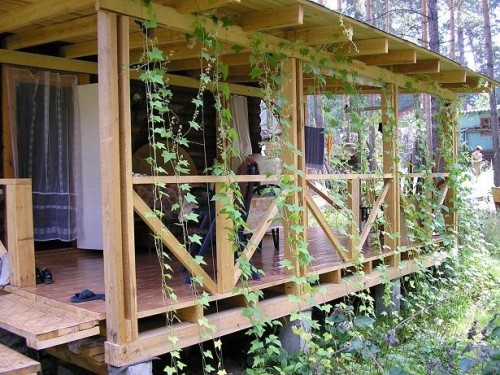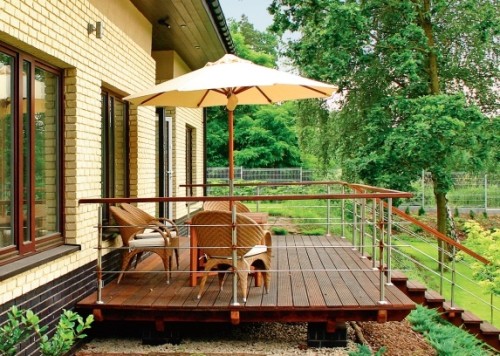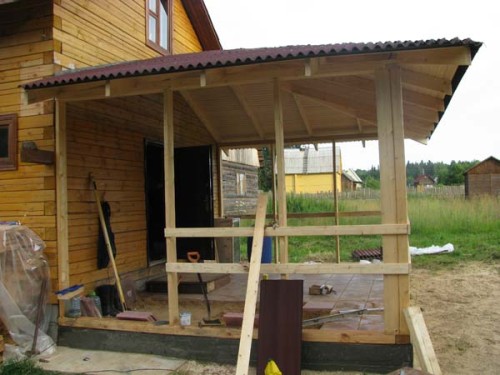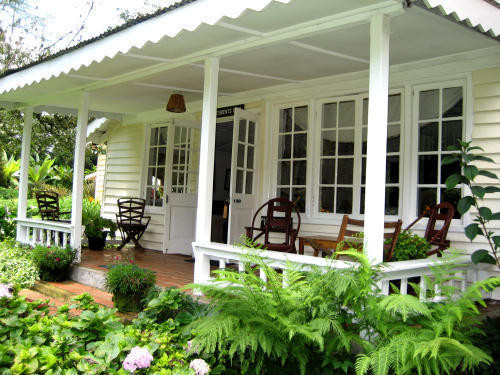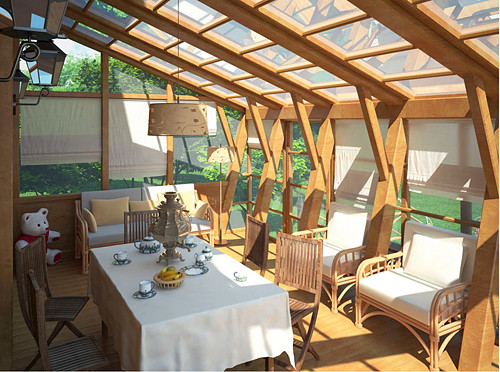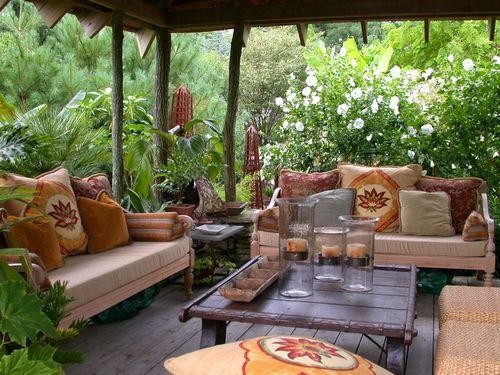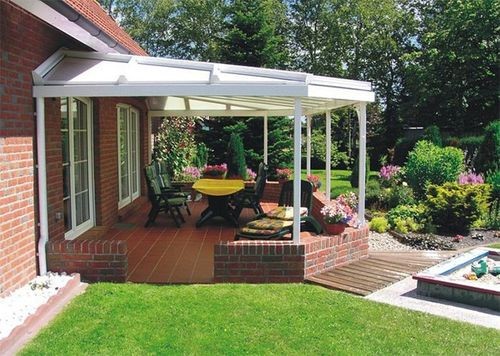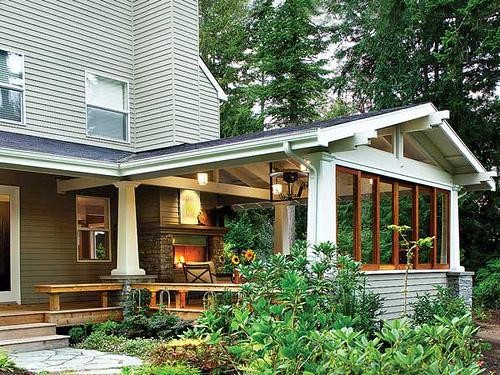The veranda in the country can be bolden by one of the best places to relax in the fresh air. She is perfectly covered by summer heat. This extension is possible to operate in winter, for example, as a dining room where the whole family can be gathered. The veranda is usually not considered a residential premises, so you should not have difficulties with the design of the necessary documents for its construction.
Content
Characteristics of the building
There are several options for building this building, some of which we now consider. But for a start, let's learn what type there are verandas. The easiest option will be erected by an open veranda in the country. Outwardly, it looks like a small platform, canopy with special fences. The disadvantage of such a design is that it cannot be used in winter. A closed veranda will be much more comfortable. This building, in addition to the above above, there are walls and windows. Thanks to this, it is comfortable in any weather. This is perhaps the most optimal option for private homeowners.
There is another type of veranda - combined. It consists in building a wall that, if necessary, can be removed, and if you need, put it in place again, for example, in the winter. So that these actions are easier to implement, the walls are usually done by wooden. Today the so-called French veranda is gaining popularity. In its design, metal plastic bags are used.
Sometimes people mix such concepts as a veranda and terrace. Although, in fact, these are different structures that have a different structure and goal. For example, the terrace is an open platform located on the foundation. Sometimes it is covered with the roof. The terrace is usually built for rest. As for the veranda, it is most often created as a cold room. At the same time, it usually adjoins the entrance door, is its protection. The terrace is not attached to the house. The veranda is most often closed. The terrace has no walls. The size of the verandas may be small. The terrace, in turn, is done so that there is a lot of place to relax with all residents of the house and guests.
It is worth mentioning a gazebo, which is something similar to the terrace, built separately from the main building. In arbors, fences are usually made around the perimeter, which can be made in the form of railings, woven grids, forged either brick fences, a height of about 1 m. As for the terrace, it does not have any restrictions. Even the pillars that serve as a roof support are not always made. If they are put, then in some cases, there are planks that perform the role of railings.
Preparatory work
So how to make a veranda in the country? Before starting construction, it is necessary to determine the type of design that you want to build. When choosing, think about what purpose you need it. When you decided on the type of construction, you need to choose the material for the construction of the veranda in the country with their own hands. The most logical to choose the same from which the house is built. In addition, it is necessary to choose a suitable location for the construction, draw a sketch of the future veranda, to draw up as a detailed construction plan as possible, as well as choose the type of foundation.
When selecting a place under the veranda, it is necessary to take into account not only the practical, but also the aesthetic side of the question. In particular, it is desirable to choose a plot so that at least one of the walls of the main building protect the veranda from a strong wind. It will also solve the problem with the insulation of an extension, if it is a closed veranda. In addition, a beautiful view should be opened from it. This may be, for example, a river view or an original building standing next door. In the end, the choice remains yours.
Material for building veranda in the country
The choice of material depends on what strength, you think there should be an extension. In any case, it is necessary to build a foundation. The same design itself is most often performed from wood. For French type veranda, metal plastic is most often used. Wooden lags will be required for the floor. Sometimes there is still a linoleum or ceramic tile. As for the roofing material, today the slate, metal tile is most often used for this purpose. Often, professional flooring and soft tile also applied. Before making a choice in favor of this or that material, it is recommended to know more about the technical characteristics of each of them.
Brick veranda
Brick is one of the best materials for buildings. If you do a trust of it, then it will be cool in the summer. In addition, such a veranda is much fireproof than the design of wood. In addition, the brick veranda is durable, does not require much care. Brick buildings have small heat loss, which is very important in winter. In order to be able to use such a veranda in the cold season, it is enough to hold a heating and glazed in two glasses. From the disadvantages it should be noted primarily a large weight of the design. Therefore, under the brick veranda will have to construct a belt foundation.
Polycarbonate veranda
Cellular polycarbonate is gaining increasingly popular. This is a transparent material with good thermal insulating properties. Moreover, the indicators of thermal insulation vary depending on the thickness, the type of cell and the number of layers. Thanks to the plasticity of this material, its sheets can be bent into a variety of forms.
This material can be used for the construction of walls and roofs. If such a veranda conduct heating, there will be comfortable even in winter. As for the disadvantages of such facilities, they certainly are. For example, do not make the veranda of polycarbonate on the south side. Otherwise, there will be hot. To this was not, it will have something obscure and ensure normal ventilation.
Construction technology of erection
In this case, fit different types of foundations, but most still use columnar, at least - and pile tape type. If the extension is adjacent to the country house, it is best to use the same kind of basis as that for the main building.
The base is built as follows:
- Please is dug pit depth which should be about 1.1 m.
- Then, at the bottom it is a special pillow of sand about 210 mm thick.
- The walls of the pit must be covered with roofing material.
- Thereafter, the concrete mix is \u200b\u200bpoured into the hole and thus obtained concrete layer.
- When the base is hardened, it is being built brick pillar desired height.
Further work on the construction carried out in the following order:
- After the foundation is usually made floors and supporting structures. The best choice for the floor to be solid plank, with the exception of options when using solid foundation.
- In any case it is necessary to raise the supporting columns. Thanks to them, the main burden will fall on the basis of built for this purpose, rather than on the floor.
- If you do decide to make a solid foundation, in this case, it is desirable to build a stone support. Before installing wooden posts must first assemble the frame of the roof, and after that to start the installation process.
- It is important that the upper part of the support is securely fixed to the frame. While the lower part will stand under its own weight. As an attachment, you can use metal corners or long screws. Those and other screwed from above, namely, the upper end of the beam, which is the reference. This way you do, so that the connection will be imperceptible. Between adjacent support beams should be a distance not less than 2.1 m.
- After installing the columns, you can proceed directly to the floor mounting. It is worth noting that different outdoor materials have their own characteristics in this process. In general, many materials are suitable for this purpose, but also those that are not recommended to use. In particular, it concerns tile. It's easier and faster to use OSB plates, then put on them linoleum.
- When the floor is ready, you can proceed to the construction of the roof. In order to make high-quality roof, it is necessary to consider the features of the climate. If there are strong winds in your region, then it is necessary that the roof is covered completely. So the wind is not for what will cling to disrupt the roofing material. In addition, it is important to make the right angle of inclination, which is selected depending on the roofing material used. For example, for a professional flooring, it should be 23 degrees, for the foundations of bitumen - at least 10 degrees, and for slate about 24 degrees.
- If your region is frequent precipitation, then when the roof is erected, first of all, it is worth thinking about a high-quality drainage. In addition, in this case, it is necessary to insulate the roof adjoining to the main building. The angle of inclination should be up to 35 degrees.
- It is important to take into account that single-table roofs should not be too long (optimally up to 3 m). Otherwise, in winter, it will be too long to lie on them, which itself is for the roof of a fairly large load, which columns serving support may not withstand.
- When the roof is erected, it is necessary to collect rafting farms, then install them and secure. The following should be extended and insulation. The last responsible step is to lay a roofing material.
- So-called rafter farms are usually assembled according to the console type, and it is possible to install them in a standard way or use additional bases for this purpose. If the roof length is not more than 1.9 m, then the standard version of the rafter is suitable, which looks like a rectangular triangle elongated shape. If the roof is larger, then an option with an additional support in the form of beam, to which the beam and rafters is attached. In this case, the angle of inclination can be from 80 to 40 degrees.
- The supporting beam is attached to the wall of the main building with the help of a dowel, between which should be at least 500 mm. This element can withstand the roof even without reference columns. Only in this case the roof in length should not be more than 2.4 meters.
- During the construction of the veranda, try to refer to the construction of the roof with a special responsibility. In particular, for a single-table roof is allowed so that between the farms was a distance of 500 mm.
- When the roof frame is installed, you can start the extender. Semide is recommended only the canvas that will be the basis for fastening the roofing material. You do not need to overload the roof of the roof.
- It may seem that on the veranda it would be nice to establish vapor barrier, but in fact it is superfluous, because here and so sufficiently good air circulation. But the waterproofing is worth doing. To do this, you can use a special film that is installed on top of the box.
- Finally, it is possible to lay roofing material. With any of your choice it is best to prepare and trim on Earth. During operation, the cover should be topped down with rows. It is recommended to use screws or nails with an insulating gasket as fixtures.
Finishing veranda
When the main works on the construction of the veranda are completed, you can decorate the erected annex. For this purpose, for example, you can use facing tiles, artificial stone, colored wood for wood, decorative plaster and wooden decor elements. All this allows you to create a truly unique design of an extension. The interior of the veranda will decorate the table of a round or oval shape, a rocking chair from a tree and other details for your taste. Such a decision should organically fit into the overall design of the veranda in the country.
Open verandas at the cottage: photo


